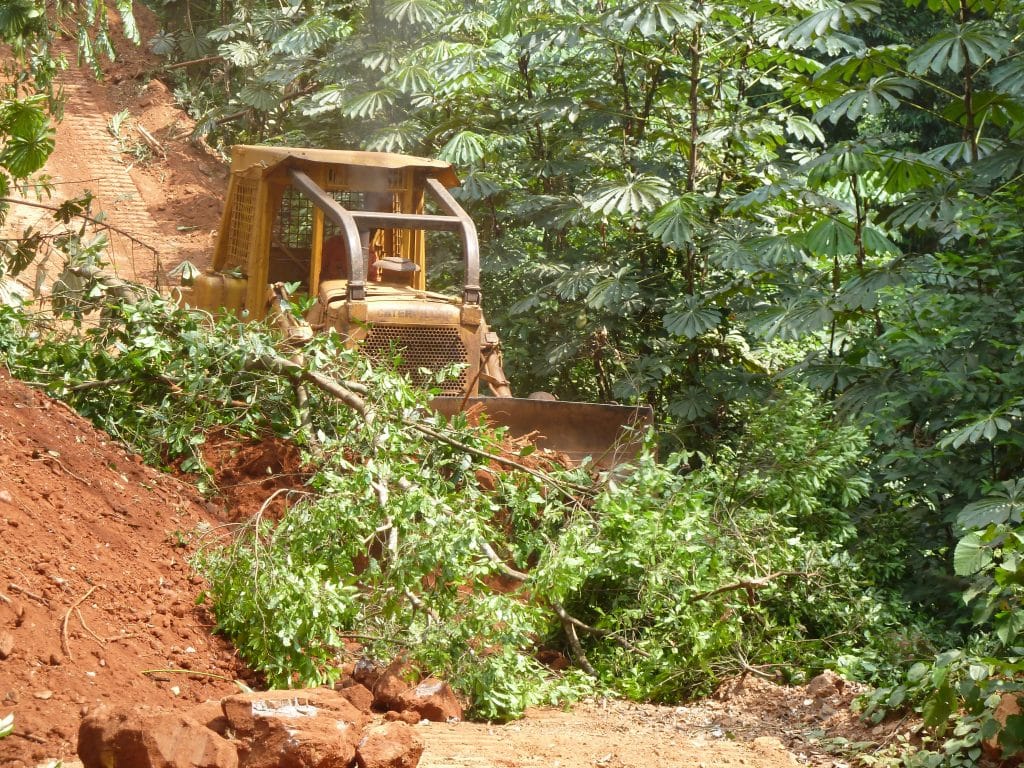Blog
We’re in the middle of a biodiversity crisis, why are we offsetting?
Posted 30th October 2021
Introduction
Biodiversity Offsetting, liked by governments, lending institutions and private sector developers it has been a mainstay solution for some time now with more countries adopting the practice. It allows developers and development to continue, even if sensitive ecosystems, habitats, or species are present. It’s the ‘can-do solution’, allowing economic progress and development to continue unabated. But does it truly replace everything which was originally lost? There has been disquiet in the scientific community for a while now and with a ‘biodiversity crisis’ upon us, scientists have identified that there is a risk of losing 1 million species by 2030 (IPBES, 2020). So why isn’t greater emphasis placed on avoidance with more focus on driving optimized use of space and resource efficiencies to counter humanity’s ever-growing impact?
Figure 1. A bulldozer clears tropical rainforest in Liberia, West Africa. Photograph by Phil Rogers.
Defining offsetting
Offsetting implies that habitats and ecosystems can be removed and replaced elsewhere. Moilanen & Kotiaho (2018) define biodiversity offsetting as “compensating damage, typically via habitat restoration, land management, or by establishment of new protected areas. It is often applied to development projects of all kinds including agriculture, energy production, extraction industries, urbanization. Offsets are the fourth step of the so-called mitigation hierarchy, in which ecological damage is first avoided, minimized second, and third restored locally”. They are only intended to be used after reasonable steps have been taken to avoid and minimize biodiversity loss (OECD, 2016).
The problem
As a mechanism to compensate for damage, concerns on instigation and approach of offsetting or its failure to deliver the originality of what was lost continue (Maron et al. 2015; Moilanen & Kotiaho, 2018). The mechanism may also provide a ‘licence’ to degrade the environment as noted by the Dasgupta Review on the Economics and Biodiversity (Dasgupta, 2021).
If offsetting is the fourth step in the mitigation hierarchy, why is it routinely discussed, used and implemented? Why is there not more robust discussion on avoidance? For developers it is easier and quicker to slide quickly down the hierarchical ladder to the fourth step of offsetting. The IUCN (2021) state themselves that “biodiversity offsets are only appropriate for projects which have rigorously applied the mitigation hierarchy framework.” The fact that this has been stated might suggest mostly the opposite happens.
If minimization and restoring is not occurring, then what is happening? Ultimately, we know this is not happening with humanity’s global footprint now more significant than ever before (Pavid, 2021). A recent study from Moody ESG Solutions also suggested that from a sample of 5,300 publicly traded global companies, 2000 have a current activity associated with habitat loss (Parker, 2021).
Can we say the science of offsetting is working? The study on the effectiveness of implanting biodiversity offsets is well documented. However, whether offsets compensate for the original loss is far less known. Some of the issues this author has come across include (for a thorough review see Bull et al. 2013):
- Defining what biodiversity values are lost, demonstrating no net loss or net gains;
- Time delays between the original habitat lost and installation of the offset;
- Quality of offset habitat may take years to replace what was originally lost;
- Poor site selection, ecological conditions elsewhere may not be the same or suitable;
- Impacts from cumulative developments on an offset;
- Poor governance on monitoring, evaluation, care and maintenance of the offset;
- Implementation of different offsetting forms (flexible and/or alternative offsetting)
A recent investigation in New South Wales, Australia has revealed “appalling practices” with government bodies failing to provide offsets and consultants pocketing millions of dollars in land purchasing. A parliamentary inquiry is now under way (Cox, 2021).
Has offsetting globally contributed towards a global Net Positive Gain? Simmonds et al. (2019) state that ‘most offsets result in an overall decline in biodiversity, which is at odds with stated goals of no net loss.’ Ironically, many of Simmonds colleagues have historically been advocates of offsetting which might suggest this is now accepted as failing to deliver. Overall, many more studies are required. However, there have been legal case studies which have tested the role offsetting has played, for example as a tool used in association with the European Union Habitats Directive. Here the European Union Court of Justice concluded that “although biodiversity offsets can still be relied upon whenever application is being made of the derogation clause under Article 6(4) of the Habitats Directive, they cannot be used as mitigation for plans and programs liable to adversely affect Natura 2000 sites.” (Schoukens & Cilquet, 2016). The authors go on to say that while the legal outcome is rigid, it is “in line with the main principles underpinning biodiversity offsetting.”
The Solution
The alternative put forward is target-based ecological compensation. This method you could say involves offsetting through ‘national nature banking’ whereby projects commit to compensating through recreating or restoring an area greater than the size of that lost for whatever threatened species are impacted. We don’t know if a target-based offsetting system will gain traction, but with the climate emergency and biodiversity crisis climbing the political agenda and requiring wholesale changes in our use of energy and how are societies are organized, it could have a role.
Figure 1. An alternative to biodiversity offsets: target-based ecological compensation.
Conclusions
The paradigm must shift back to rigorous application of avoidance and restoration. The current interest for rewilding and landscape-scale responses to the climate crisis could be the beginnings of a movement to push the agenda further up the mitigation hierarchy. Indeed, 2021 marks the start of the United Nations Decade on Restoration. We wait to see the outcomes of the delayed UN Biodiversity Conference (COP 15), and whether the Meeting of the Parties to the Convention on Biological Diversity, to be held in China, will recognize the scale of the response required, and if the updated convention will bring about the changes necessary.
About the Author: Dr. Phil Rogers is an international environmental and biodiversity specialist and is Director and Lead Ecologist for International Biodiversity Consultants Ltd. He is currently working in South East Asia and is based in Jakarta, Indonesia.
About International Biodiversity Consultants Ltd: International Biodiversity Consultants Ltd was formed in 2019 and is focused on global solutions for nature. Find out more here or link up with our social media: linktr.ee/ibioconsultant1
References
Bull, J., Suttle, B., Gordon, A., Singh, N. Milner-Gulland, E. (2013) Biodiversity offsets in theory and practice, Oryx 47 (3), 369-380. Accessed at: https://www.cambridge.org/core/journals/oryx/article/biodiversity-offsets-in-theory-and-practice/EDBF70717C273662B6D8EE0876370095
Cox, L. (2021) NSW environmental offsets to be reformed after ‘apalling practices’ revealed, minister says, Guardian Newspaper International Edition. Accessed at:
https://www.theguardian.com/australia-news/2021/oct/26/nsw-environmental-offsets-to-be-reformed-after-appalling-practices-revealed-minister-says
Dasgupta, P. (2021) The Economics of Biodiversity: The Dasgupta Review, London: HM Treasury. Accessed at: https://www.gov.uk/government/publications/final-report-the-economics-of-biodiversity-the-dasgupta-review
Intergovernmental Science-Policy Platform on Biodiversity and Ecosystem Services (2020) As Planet Burns, One Million Species in World’s Eco-System in Danger of Extinction. Accessed at: https://ipbes.net/node/36569
IUCN (2021) Biodiversity Offsets, Accessed at: https://www.iucn.org/resources/issues-briefs/biodiversity-offsets on 20 March 2021.
Moilanen, Atte & Kotiaho, Janne. S (2018) Fifteen operationally important decisions in the planning of biodiversity offsets, Biological Conservation, Vol. 227 (November 2019), pages 112-120. Accessed at: https://doi.org/10.1016/j.biocon.2018.09.002 on 20 March 2021.
OECD (2016) Biodiversity Offsets – Effective design and implementation. Accessed at: https://www.oecd.org/env/biodiversity-offsets-9789264222519-en.htm
Maron, M., Gordon, A., Mackey, B.G., Possingham, H.P., Watson, J. (2015) Conservation: Stop misuse of biodiversity offsets, Nature, 523, 401-403. Accessed at: https://www.nature.com/articles/523401a
Parker, G. (2021) Explainer: Biodiversity offsets and putting a price-tag on nature. Accessed at: https://www.eco-business.com/news/explainer-biodiversity-offsets-and-putting-a-price-tag-on-nature/
Pavid, K. (2021) What is the Anthropence and why it matters? Access at:
https://www.nhm.ac.uk/discover/what-is-the-anthropocene.html on 23 May 2021.
Schoulens, H. and Cliquet, A. (2016) Biodiversity offsetting and restoration under the European Union Habitats Directive: balancing between no net loss and deathbed conservation, Ecology and Society 21 (4): 10. Accessed at: http://dx.doi.org/10.5751/ES-08456-210410
Simmonds JS, Sonter LJ, Watson JE, et al. Moving from biodiversity offsets to a target-based approach for ecological compensation. Conservation Letters. 2020;13:e12695. Accessed at: https://doi.org/10.111/conl.12695 on 20 March 2021.
University of Queensland (2020) Biodiversity offsetting is contentious – here’s an alternative, University of Queensland UQ News, accessed at: https://www.uq.edu.au/news/article/2020/02/biodiversity-offsetting-contentious-%E2%80%93-here%E2%80%99s-alternative on 20 March 2021.

